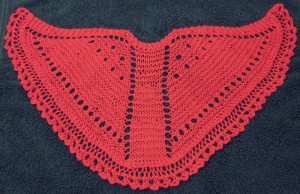The distinctive “butterfly” shaping of the Faroese shawl makes an exceptionally wearable garment because of the shaped shoulders and elongated ends for optionally tying around the waist. Another distinctive feature of Faroese shawls is a center back panel, a.k.a. gusset, that separates 2 side panels.

This Doll-sized Shawl demonstrates the distinctive characteristics of traditionally-shaped Faroese shawls
Classic Faroese shawls are knitted bottom up. Thus, you would usually start with a bunch of stitches, and the shaping would be accomplished by decreasing.
Traditional look with updated methods
In the early 1990’s when I first discovered Faroese shawls, I also was in my early days of learning to handspin my own yarn. As a novice, I was not always sure of how much yarn I would have. I feared starting a bottom-up shawl and possibly running out of yarn before completed. So I devised a top-down approach that started with just a few stitches and simulated the shaping by increasing. In this way, I was always assured of ending up with a completed, usable shawl that could be knit to the length based on the amount of yarn I had spun.
As time went on, of course I became better at handspinning and producing known amounts of yarn, lol. But I still prefer working Faroese shawls top-down. Therefore, all the Faroese shawl designs in my HeartStrings collection are worked from the neckband down. You start with just a few stitches so that you can become familiar with your yarn and the stitch patterns.
A Bit of Lace Dolly Shawl is a great way to have fun learning top-down Faroese shaping on a small shawl before putting the time into a larger shawl. This basic pattern uses simple yarn over increases to achieve the traditional center back panel, side panels, front bands, and shaped shoulders.


 HeartStrings FiberArts
HeartStrings FiberArts Knitting Bits of Lace on Facebook
Knitting Bits of Lace on Facebook Ravelry Store
Ravelry Store
I, too, enjoy making faroese shawls from the top down. I have made a couple and in the county fair won reserve champion! One I gave to a dear friend and the other I wear all the time. I always get comments on it. Thank you for the pattern! My granddaughters will love this little shawl for their babies and bears!